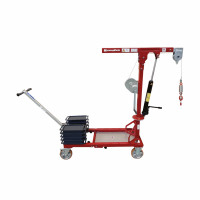UPEL350
- Max. load capacity 350 kg
- Mobile slewing jib crane with electric/battery operation
- Simple movement via radio remote control
- Load can be tilted to pass through doors and at low ceiling heights
- Tight turning circle
- Width 600 mm - specially designed for cabin aisles
- Quick pick-up function for switch cabinets
- Dead weight approx. 310 kg
 Combination with vacuum cups possible.
Combination with vacuum cups possible.
The UPEL350 is designed for one of the most common applications in industry: the UPEL350 is able to lift heavy loads and move them in different directions. Such mobile jib cranes are usually used in large production halls and are particularly suitable for areas with limited space. Hoists play an important role in increasing productivity in industrial assembly. By using hoists, heavy components can be handled faster and more efficiently, resulting in shorter assembly times.
The right choice of lifting equipment for your industrial assembly requirements
Choosing the right lifting equipment is crucial to the success of assembly processes. It is important to consider your specific requirements and select exactly the hoist that is most suitable. This includes factors such as the maximum lifting capacity of the hoist, the reach required, the type of loads to be lifted and the available space capacity. It is also important to consider the quality and reliability of the hoist as well as the manufacturer's customer service. Thorough research and consultation with experts can help you make the best choice for your industrial assembly needs.
Maintenance and care of lifting equipment in assembly
Regular maintenance and care of lifting equipment is crucial to ensure its performance and safety. It is important that hoists are checked regularly for wear and damage. Wear parts should be replaced in good time and damaged components repaired or replaced. In addition, hoists should be cleaned and lubricated regularly to ensure their smooth operation. It is also important to train operators on the correct handling and care of lifting equipment to prevent damage or accidents. Feel free to contact our competent service!
Training for hoist operators in industrial assembly
The training of hoist operators is crucial for the safety and efficiency of assembly processes. Operators should have the knowledge and skills required to use lifting equipment safely. This can be achieved through training and education programmes that cover the different types of lifting equipment, how they work and their safety requirements. Regular refresher courses and training should also be provided to ensure operators remain up to date.
Conclusion: The future of hoists in industrial assembly
Lifting equipment plays a crucial role in maximising productivity and minimising risk in industrial assembly. By using lifting equipment, heavy components can be lifted, positioned and assembled safely and precisely. This leads to reduced assembly times, increased output of finished products and improved safety for operators. The future of hoists in industrial assembly looks promising as new technologies and innovations continue to improve the performance and efficiency of hoists. It is important that companies recognise the benefits of hoists and integrate them into their assembly processes in order to remain competitive and produce high quality products.
| Load capacity : | 350 kg |
| Dead weight: | 310 kg |
| Length : | 1,50 m |
| Width: | 0,60 m |
| Height: | 1,560 m |
| Radio remote control: | Yes |
| Transport: | self-propelled |





















